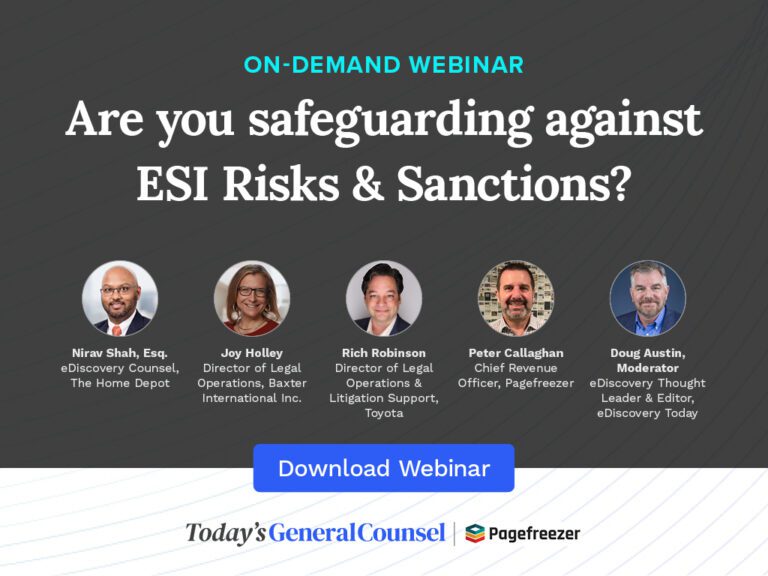Legal Experts Discuss ESI Risks and Sanctions, Pagefreezer Survey Results
June 10, 2024
Legal Experts Discuss ESI Risks and Sanctions, Pagefreezer Survey Results
Is your legal team adequately prepared to safeguard against ESI risks and sanctions?
Pagefreezer’s 2024 ESI Risk Management & Litigation Readiness Report, which is based on a survey of in-house legal professionals, can help you answer that question. Today’s General Counsel and Pagefreezer hosted a recent webinar in which a panel of industry insiders discussed the report and how its key findings play out in the real world for legal departments.
The report provides a rare glimpse into how over 200 legal departments are navigating ESI (electronically stored information) challenges, reducing risks associated with ESI, and increasing efficiency and litigation readiness.
Key findings included:
- Heavier caseloads are leading to slower response times, fines and an inability to produce ESI.
- Inadequate staffing and inefficient or difficult-to-use technology are reducing efficiency.
- Technology challenges are wide-ranging and impact most legal departments.
- Most legal teams rely on IT for ESI tasks but this has major drawbacks and challenges.
- Less than half of organizations have a mature data retention policy for any data source.
Doug Austin, eDiscovery Today Editor-In-Chief, moderated the panel, which featured the following participants:
- Nirav Shah, eDiscovery Counsel at The Home Depot
- Joy Holley, Director of Legal Operations at Baxter International Inc.
- Rich Robinson, Director of Legal Operations and Litigation Support at Toyota North America
- Peter Callaghan, Chief Revenue Officer at Pagefreezer
Robinson talked about the challenges of electronic discovery and existing technology that was designed for paper review workflows.
“We’re constantly trying to figure out how to get a square peg through a round hole. We have technology that was designed for an earlier generation of responsive materials. We are still working today with eDiscovery review applications and platforms that were designed to mirror paper review. So the fact that we’re trying to kind of push that paper review workflow onto what is now modern communication and collaboration platforms…creates natural issues and problems.”
Unprecedented Pace
Holley echoed that sentiment and noted the unprecedented pace of change legal departments are experiencing.
“So I think the bar has really been raised not only in terms of expectations but with the availability of new technology to point toward discovery obligations and also, attendant with that, the obligation to train up or to form strong partnerships with partners and counsel that can assist,” said Holley.
Rethinking Workflows
Shah stressed the importance of optimizing people, process and technology in workflows.
“Are there opportunities to do certain things in parallel? I think a lot of the times people think they have to complete one step before they move to the second, right? If you can sort of develop some workflows where you can move different work streams along at the same time, that could certainly help you,” Shah said.
“Look at options in technology. A lot of technology platforms and software that we use these days have automated workflows, automated processes,” Shah said. “Are there ways that you can leverage those in order to…sort of keep the ball moving while other people are working?”
Register here to listen to a recording of the webinar.
Get the free newsletter
Subscribe for news, insights and thought leadership curated for the law firm audience.





